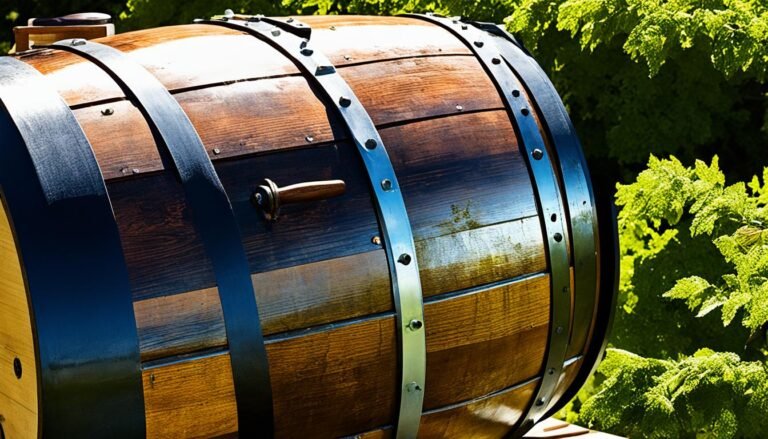One beautiful summer evening, as the sun was setting over the vineyard, I found myself sipping a glass of exquisite wine at an outdoor wine bar. The atmosphere was enchanting, with the scent of blooming flowers mingling with the earthy aroma of the aged oak barrels that surrounded me. I couldn’t help but marvel at the craftsmanship and history embodied by these wine barrels, knowing that they played a crucial role in producing the fine wines I was enjoying.
However, as I looked closer, I noticed signs of wear and tear on some of the barrels. The harsh weather conditions and exposure to the elements had taken their toll, threatening to diminish the quality and longevity of these precious vessels. It became evident that protecting wine barrels outside required thoughtful maintenance and care to preserve their rustic charm and ensure their continued use.
Key Takeaways:
- Proper maintenance is crucial for protecting wine barrels outside and extending their lifespan.
- Regular cleaning is essential to eliminate impurities and bacteria that can affect the wine’s flavor.
- Swelling a barrel before use helps ensure a tight seal and optimal aging conditions for the wine.
- Positioning and covering the barrels in a sheltered area shields them from dust, debris, and excessive moisture.
- Conducting regular inspections and addressing any wear or damage promptly helps maintain barrel quality.
Wine Barrel Cleaning
Cleaning wine barrels is an essential part of wine barrel maintenance to ensure the purity and taste of the wine. Proper cleaning removes impurities, bacteria, and residual flavors, creating a clean environment for aging wine. Here’s a step-by-step guide on how to clean a wine barrel:
- Rinse with Water: Begin by rinsing the barrel thoroughly with water. This helps remove any loose debris or sediment.
- Use a Cleaning Solution: Next, prepare a cleaning solution specifically formulated for wine barrels. Follow the instructions provided by the manufacturer to create the appropriate solution.
- Swab with a Sulfur Stick: Dip a sulfur stick into the cleaning solution and swab the inside of the barrel. Sulfur helps eliminate unwanted bacteria and odors.
- Final Rinse: After swabbing, rinse the barrel again with water to remove any remaining cleaning solution or sulfur.
Regular cleaning of wine barrels is recommended to maintain their quality and prevent off-flavors or spoilage. It’s best to clean the barrels immediately after emptying or when switching wines to avoid contamination.
“Cleaning wine barrels is an essential step in preserving the quality and taste of the wine. Regular maintenance ensures the barrels remain free from impurities and provide the ideal environment for aging.”
| Benefits of Wine Barrel Cleaning | Consequences of Neglecting Cleaning |
|---|---|
|
|
How to Swell a Barrel
Before aging wine in a new or dry barrel, it’s important to properly swell the wood to prevent leakage and ensure optimal aging conditions for the wine. Here’s a step-by-step guide on how to swell a wine barrel:
- Fill the barrel with water: Start by filling the barrel with water, submerging it completely. This allows the wood to absorb moisture and expand, sealing any potential leaks.
- Monitor for leakage: Once the barrel is filled with water, carefully observe if any leaks occur. Pay close attention to the barrel staves, the ends, and other joints. If you notice any leaks, mark them for repair.
- Empty the barrel: After monitoring for leaks for at least 24 hours, empty the barrel of the water. This step ensures that the excess water is removed from the barrel.
By following these steps, you can swell the barrel, creating a tight seal and preparing it for use in aging wine. Swelling the wood not only prevents leakage but also contributes to the development of unique flavors and aromas as the wine matures.
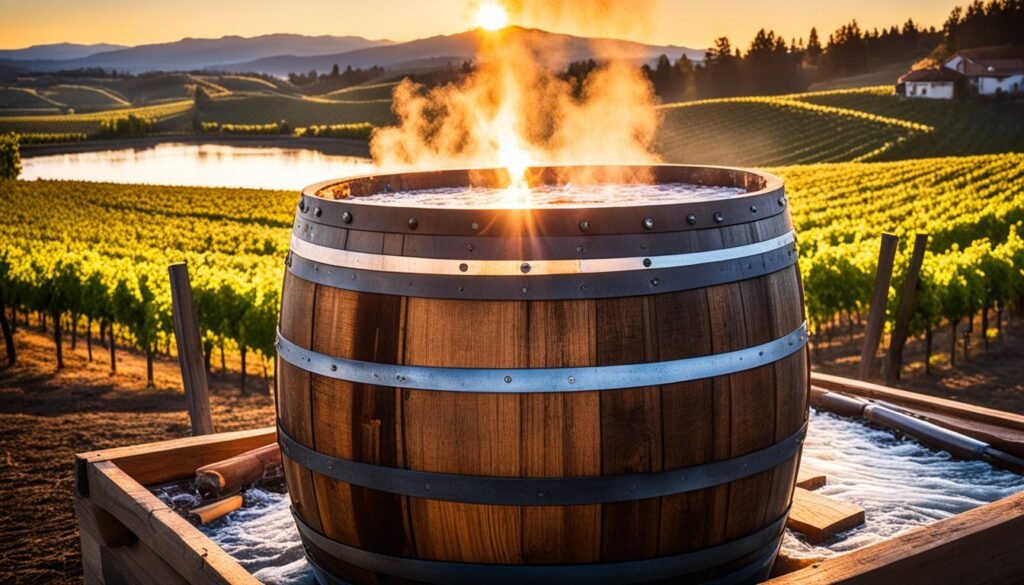
Once you’ve successfully swollen the barrel, it’s ready to be prepared for wine aging. In the next section, we’ll explore the steps to prepare a barrel for aging, ensuring that the wine ages beautifully and develops its full potential.
How to Protect a Wine Barrel Outside
When it comes to storing wine barrels outdoors, proper protection is crucial to maintain their quality and preserve their integrity. Here are some practical tips on how to protect your wine barrel from the outdoor elements:
- Positioning: Find a sheltered area where the wine barrel will be shielded from direct sunlight, rain, and extreme temperatures. This will help prevent damage and maintain the quality of the wine.
- Barrel Covers or Tarps: Use barrel covers or tarps to provide an extra layer of protection against dust, debris, and UV rays. Make sure the covers are properly secured to keep the barrel fully covered.
- Elevate the Barrel: Place the wine barrel on a sturdy and elevated platform to prevent moisture absorption from the ground. This will help avoid rotting or warping of the wood, ensuring the longevity of the barrel.
- Regular Inspections: Conduct regular inspections to check for any signs of wear, damage, or pest infestation. Look out for cracks, leaks, or loose staves, and address any issues promptly to prevent further deterioration.
By following these tips, you can effectively protect your wine barrel from outdoor elements and ensure its longevity. Remember, proper maintenance and care are essential for preserving the quality of the barrel and the wines it produces.
Protecting your wine barrel outside is a vital aspect of wine barrel maintenance. With the right precautions and upkeep, you can safeguard your investment and continue enjoying the delights of aging wine in a well-preserved barrel.
How to Maintain a Barrel
Proper maintenance is essential for ensuring the longevity of wine barrels and preserving their quality. By following these tips, you can effectively maintain your wine barrels and maximize their lifespan.
Regular Cleaning
Regular cleaning is crucial for keeping wine barrels in optimal condition. To clean a barrel, start by rinsing it thoroughly with water to remove any debris or residue. Then, use a cleaning solution specifically formulated for wine barrels to ensure a thorough cleaning. This helps eliminate impurities and bacteria that can negatively impact the wine’s flavor.
Inspect for Loose or Damaged Staves
Periodically inspect the barrel for any loose or damaged staves. Staves are the individual pieces of wood that make up the barrel’s body. If you find any loose staves, they should be repaired or replaced promptly to maintain the barrel’s structural integrity and prevent leaks.
Proper Rotation and Storage
Rotating and storing the barrels correctly is essential for their maintenance. Regularly rotating the barrels helps distribute the wine inside, preventing the formation of sediments and ensuring consistent aging. Additionally, it’s important to store the barrels in a cool and dry environment to avoid excessive temperature fluctuations, which can affect the wine’s quality and the barrel’s integrity.
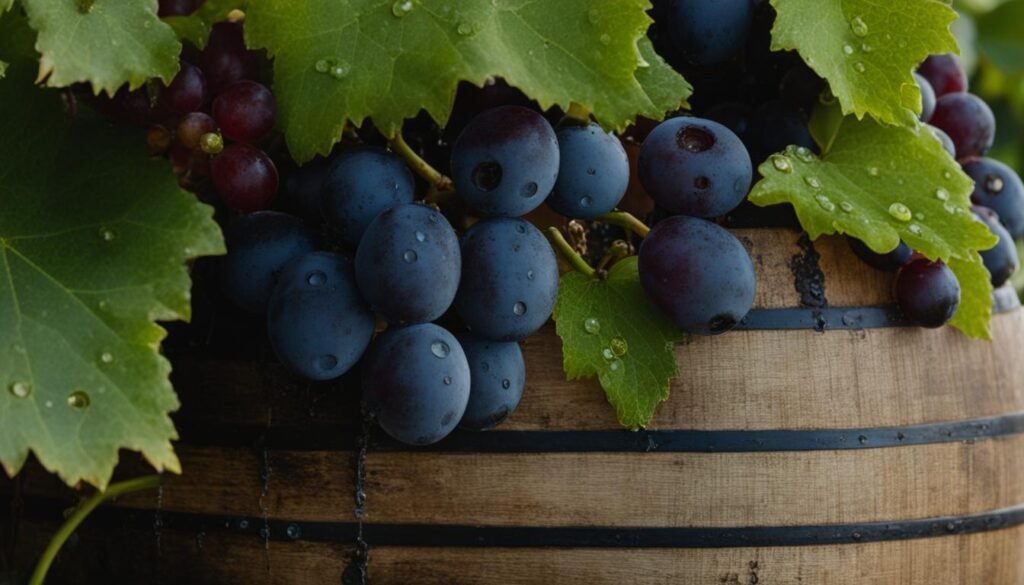
How to Keep a Dipping Barrel Clean
Dipping barrels are essential for topping up wine in other containers, but proper maintenance is crucial to ensure the quality of the wine remains intact. In this section, I will provide you with tips on how to clean and maintain a dipping barrel to keep it clean and bacteria-free.
Separate Use for Different Wines
When using a dipping barrel for different types of wine, it’s important to segregate the barrels. This helps prevent cross-contamination and maintains the distinct flavors of each wine. Dedicate separate barrels for different wine varietals to preserve their individual characteristics.
Regular Cleaning and Sanitizing
To maintain the quality of the dipping barrel, regular cleaning is necessary. Clean the barrel thoroughly after each use to remove any residual wine or sediment that may impact the flavor. Use a cleaning solution specifically formulated for wine barrels and follow the manufacturer’s instructions for best results. Repeat the cleaning process every few weeks or as recommended.
Note: Regular cleaning and sanitizing help eliminate bacteria or yeast that could spoil the wine.
Swabbing with a Sulfur Stick
Swabbing the interior of the dipping barrel with a sulfur stick is an effective way to prevent bacterial and yeast growth. The sulfur helps to kill any potential contaminants and keeps the barrel clean and hygienic. It’s recommended to swab the barrel with a sulfur stick after every cleaning session or as needed.
“Regular cleaning and swabbing with a sulfur stick are essential steps to maintain the cleanliness and integrity of a dipping barrel.” – Wine Barrel Maintenance Expert
Proper Storage and Inspection
When the dipping barrel is not in use, store it in a clean and dry area. Avoid exposing the barrel to extreme temperatures or direct sunlight, as these can affect its longevity. Additionally, regularly inspect the barrel for any signs of damage or leaks. Timely repairs or replacements can prevent further deterioration and ensure the barrel’s effectiveness.
Summary
Maintaining a clean dipping barrel is vital for preserving the quality and taste of the wine. By following these tips for separate use, regular cleaning, swabbing with a sulfur stick, and proper storage and inspection, you can ensure the long-lasting performance of your dipping barrel and enjoy the best possible wine-topping experience.
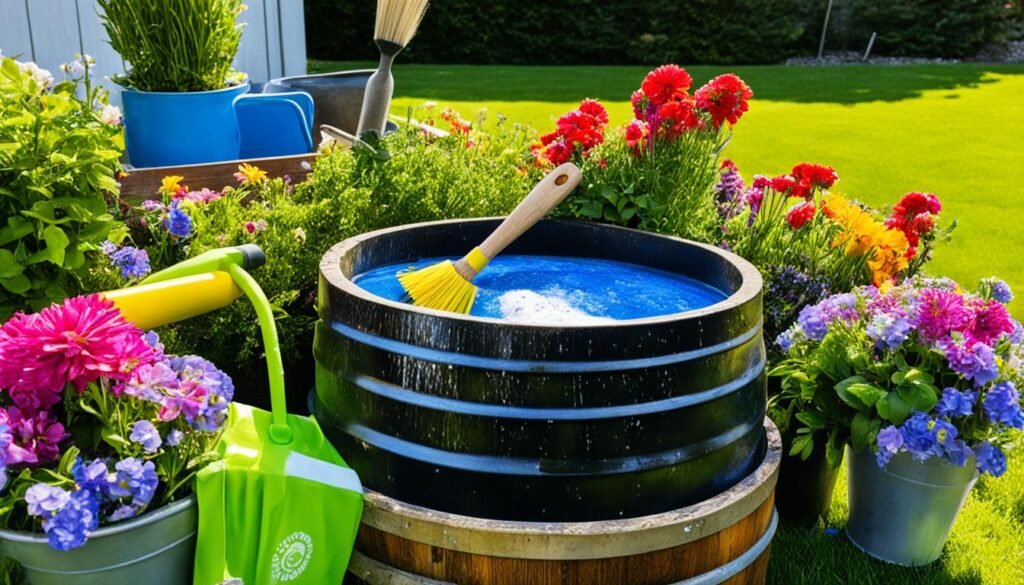
How to Prepare a Barrel for Aging
Before delving into the art of aging wine in a new barrel, it is crucial to understand the importance of proper preparation. Taking the necessary steps to ensure the barrel is ready for the aging process can make a significant difference in the final product’s flavor, aroma, and overall quality.
One of the initial steps in barrel preparation is swelling. This process is crucial to prevent leakage and maintain a tight seal. To swell the barrel, it should be filled with water. Carefully monitor the barrel for any signs of leakage, as this indicates that more time is needed for the wood to expand and seal properly. Once the barrel is deemed leak-free, it can be emptied in readiness for the next phase of preparation.
Following the swelling process, it is essential to thoroughly rinse and soak the barrel. This helps remove any residual impurities and prepares the wood for the aging of the wine. A thorough rinse with clean water, both inside and out, ensures a clean and sanitized barrel.
After rinsing, it’s time to soak the barrel. Fill it with water and let it sit for several days to allow the wood to absorb water, which will help create a stable environment within the barrel during the aging process. This soaking process also helps to reveal any potential leaks that were not apparent during the swelling stage.
Once the rinsing and soaking are complete, the barrel is ready to be filled with wine for the aging process. Carefully select the wine that complements the characteristics of the barrel and, ultimately, desired flavor profiles. Pouring the wine into the prepared barrel signals the beginning of the aging journey.
Remember, proper preparation sets the foundation for a successful aging process. The steps outlined above—swelling, rinsing, soaking, and filling—are essential for creating optimal aging conditions and achieving the desired flavors and aromas in the final product.
The Swelling Process
The swelling process is a critical step in preparing a wine barrel for aging. It ensures a tight seal to prevent leakage and optimize the aging conditions within the barrel. By filling the barrel with water, closely monitoring for any signs of leakage, and emptying it once properly sealed, winemakers can set the stage for successful wine aging.
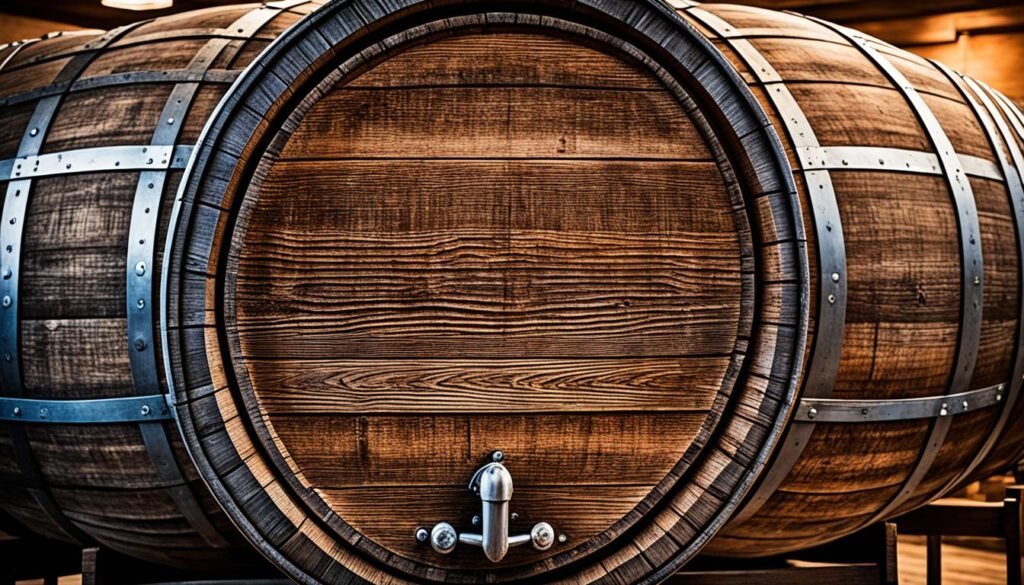
| Steps for Preparing a Barrel for Aging |
|---|
| 1. Fill the barrel with water to allow it to swell and create a tight seal. |
| 2. Monitor the barrel for leakage and ensure a proper seal is achieved. |
| 3. Rinse the barrel thoroughly with clean water to remove impurities. |
| 4. Soak the barrel in water to allow the wood to absorb moisture. |
| 5. Empty the barrel and fill it with the chosen wine for the aging process. |
How to Treat an Aging Barrel
As wine ages in the barrel, it requires proper care to achieve the desired flavors and aromas. Here are some essential tips for treating an aging barrel:
- Regular Sampling: Consistently tasting the aging wine allows you to monitor its progress and make necessary adjustments.
- Topping Up the Barrel: To minimize wine-air interaction and maintain the integrity of the aging process, regularly top up the barrel with additional wine.
- Aging Wine Appropriately: Different wines have varying aging requirements. Ensure you understand the specific needs of your wine and adjust the aging time accordingly.
By following these tips, you can maximize the quality of your aging wine and unlock its full potential.
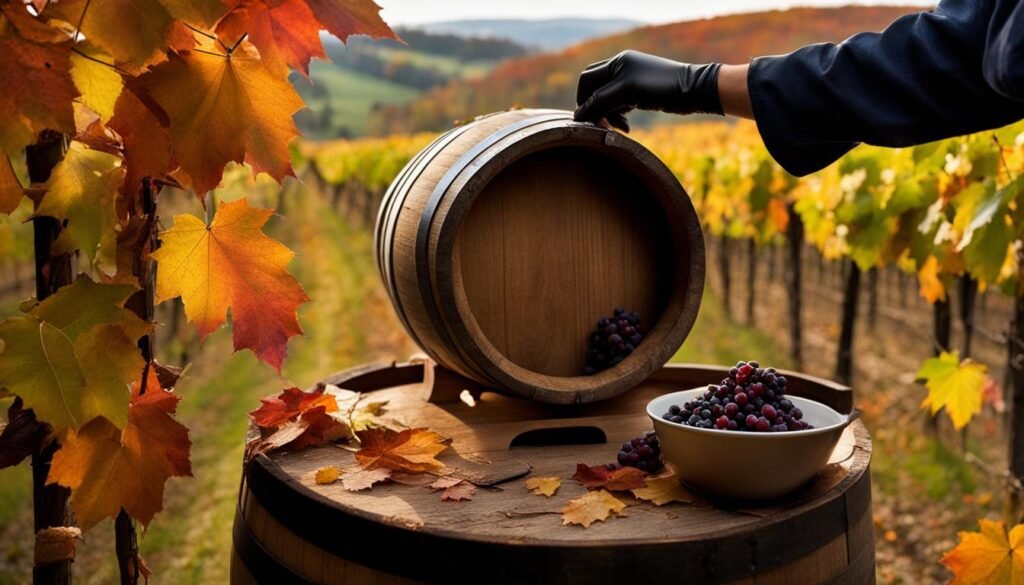
Conclusion
In conclusion, proper care and maintenance are crucial for preserving the quality and longevity of wine barrels. By following the maintenance tips outlined in this article, you can ensure that your barrels remain in optimal condition, allowing for the production of high-quality wines.
Regular cleaning using a specialized cleaning solution and swabbing with a sulfur stick help eliminate impurities and bacteria, safeguarding the purity and taste of the wine. Swelling the barrel before use prevents leakage and creates an ideal environment for aging the wine.
To protect wine barrels stored outdoors, position them in a sheltered area, use barrel covers or tarps to shield against dust and debris, and regularly inspect for wear and damage. Additionally, maintaining barrels by inspecting for loose or damaged staves, rotating, and storing them properly helps to preserve their condition and extend their lifespan.
By treating aging barrels with care, such as regularly sampling, topping up if necessary, and aging the wine appropriately, you can maximize the quality and flavor development of the wine. Overall, following these wine barrel care tips and incorporating them into your maintenance routine will ensure the preservation of the barrels’ quality and the production of outstanding wines for years to come.
